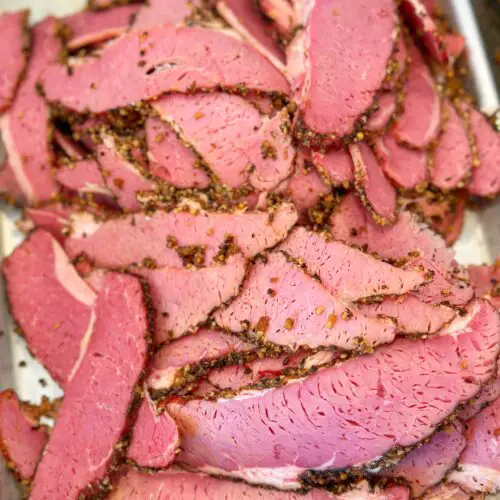Pastrami vs Salami: A Delicious Battle
When it comes to cured meats, pastrami and salami are two popular choices that have captured the hearts and taste buds of food lovers around the world. These delectable delights offer a burst of flavors and textures that can elevate any sandwich or charcuterie board. In this article, we will dive into the world of pastrami and salami, exploring their origins, ingredients, preparation methods, and ultimately, determining which one reigns supreme. So, let's embark on this culinary journey and unravel the pastrami vs salami showdown.

Pastrami vs. Salami
1. Origins:
1.1 Pastrami:
Pastrami is believed to have originated in Eastern Europe, particularly among Jewish communities.
It was traditionally made by curing beef brisket with a special blend of spices and then smoking it to perfection.

Pastrami
1.2 Salami:
Salami, on the other hand, hails from Italy and has a rich history dating back centuries.
It was created as a means to preserve meat, utilizing a mixture of ground meat, fat, and various seasonings, which were then fermented and air-dried.

Salami
2. Ingredients:
2.1 Pastrami:
Pastrami typically consists of beef brisket, which is heavily seasoned with a blend of spices such as black pepper, coriander, garlic, and paprika. The curing process involves brining the meat in a flavorful liquid before it is smoked and steamed.
2.2 Salami:
Salami can be made from various meats, including pork, beef, or a combination of both. The meat is ground, mixed with fat, salt, spices, and sometimes wine or other flavorings. The mixture is then stuffed into casings and left to ferment and dry.
3. Preparation Methods:
3.1 Pastrami:
To prepare pastrami, the beef brisket is first coated with a spice rub and then left to cure for several days. After the curing period, the meat is smoked at a low temperature to infuse it with a smoky flavor. Finally, it is steamed to enhance its tenderness before being sliced thin.
3.2 Salami:
Salami preparation involves grinding the meat, fat, and other ingredients together and then stuffing the mixture into casings. The salami is then left to ferment, which allows the development of tangy and complex flavors. It is subsequently air-dried for a specific period, during which it gains its characteristic texture and taste.
4. Flavor Profile:
Pastrami and salami offer distinct flavor profiles that cater to different palates.
4.1 Pastrami:
Pastrami boasts a robust and smoky flavor with a hint of spiciness from the seasoning blend. It has a tender and slightly fatty texture that melts in your mouth, providing a delightful eating experience.
4.2 Salami:
Salami offers a savory and tangy taste that varies depending on the spices used in the recipe. It has a chewy texture with a pleasant amount of fat, which adds richness and depth to each bite.

Pastrami on a platter vs. Salami on a pizza
5. Comparison:
In this section, we will compare pastrami and salami based on various factors.
| Factor | Pastrami | Salami |
|---|---|---|
| Origin | Eastern Europe | Italy |
| Main Ingredient | Beef Brisket | Pork, Beef, or both |
| Curing Process | Smoking and Steaming | Fermentation and Drying |
| Flavor | Robust, Smoky, Spicy | Savory, Tangy |
| Texture | Tender, Slightly Fatty | Chewy, Rich |
6. Culinary Uses:
6.1 Pastrami:
Pastrami is most commonly associated with deli-style sandwiches, particularly the iconic Reuben sandwich. It pairs well with rye bread, mustard, and pickles, creating a harmonious blend of flavors and textures.
6.2 Salami:
Salami is a versatile ingredient that can be enjoyed in various ways. It can be sliced and added to charcuterie boards, used as a topping for pizzas, or incorporated into pasta dishes and salads, bringing its distinct taste to every bite.
In the battle of pastrami vs salami, it's difficult to declare a clear winner as both these cured meats have their unique qualities and fan bases. Whether you prefer the smoky and tender notes of pastrami or the savory tanginess of salami, one thing is for sure - they both hold a special place in the culinary world. So, next time you're at a deli or planning a charcuterie spread, don't hesitate to indulge in the deliciousness of pastrami and salami.